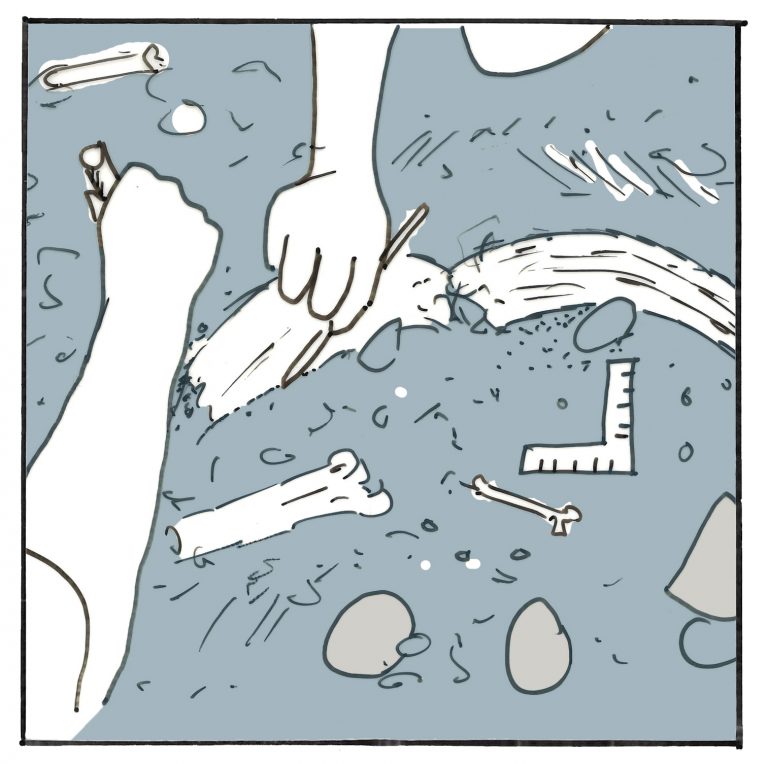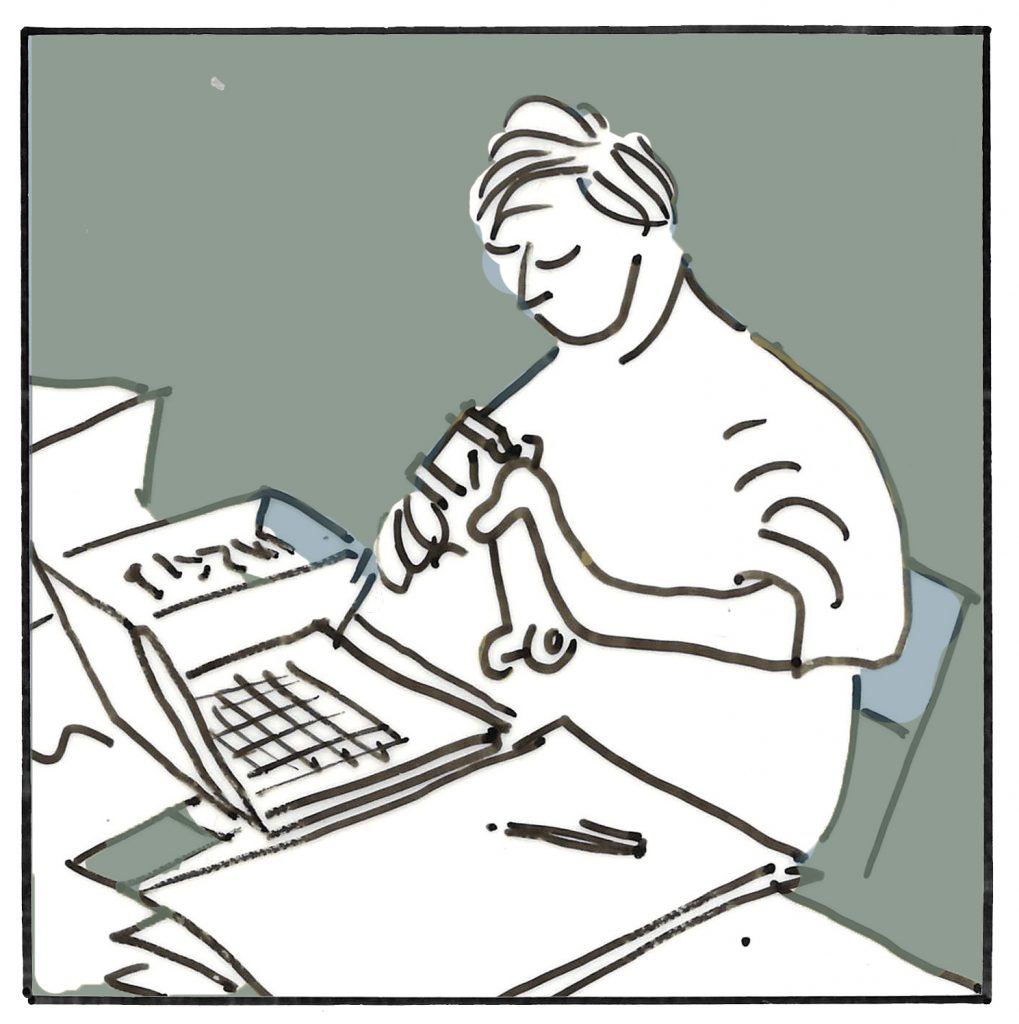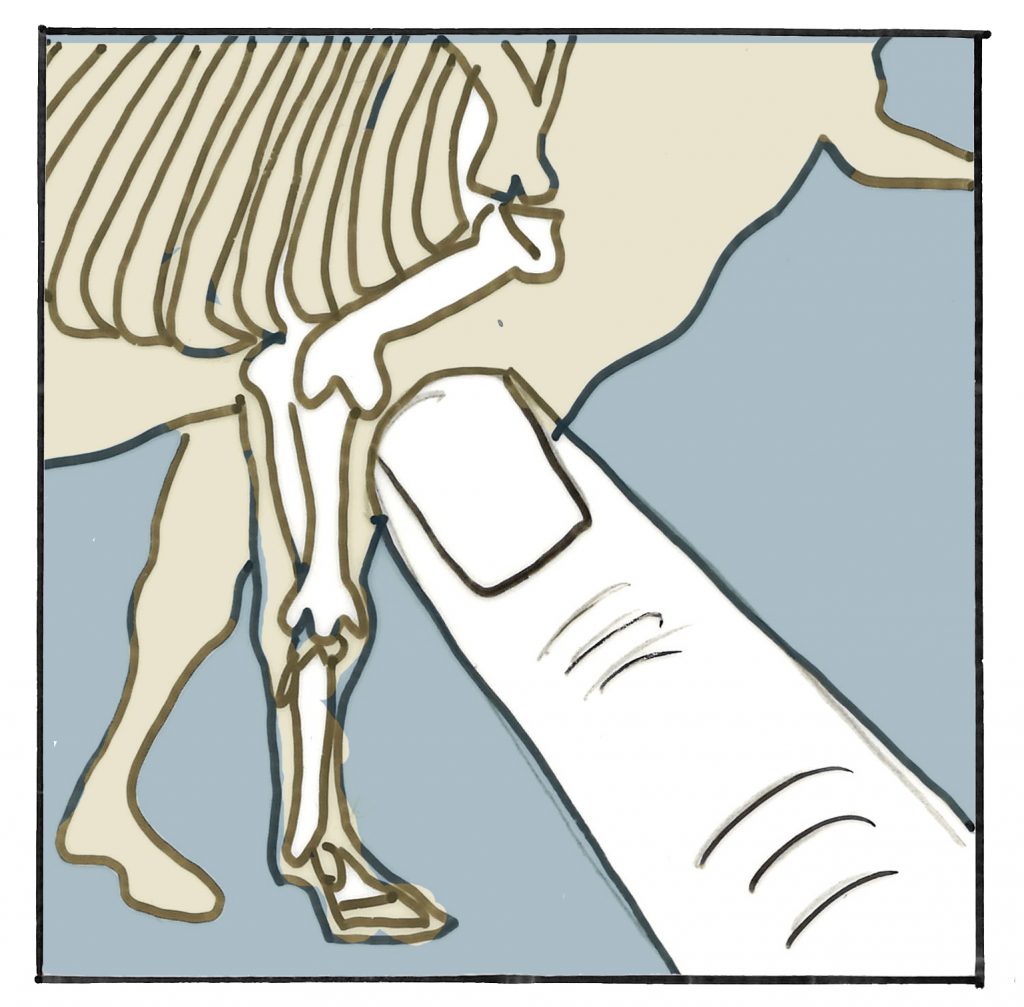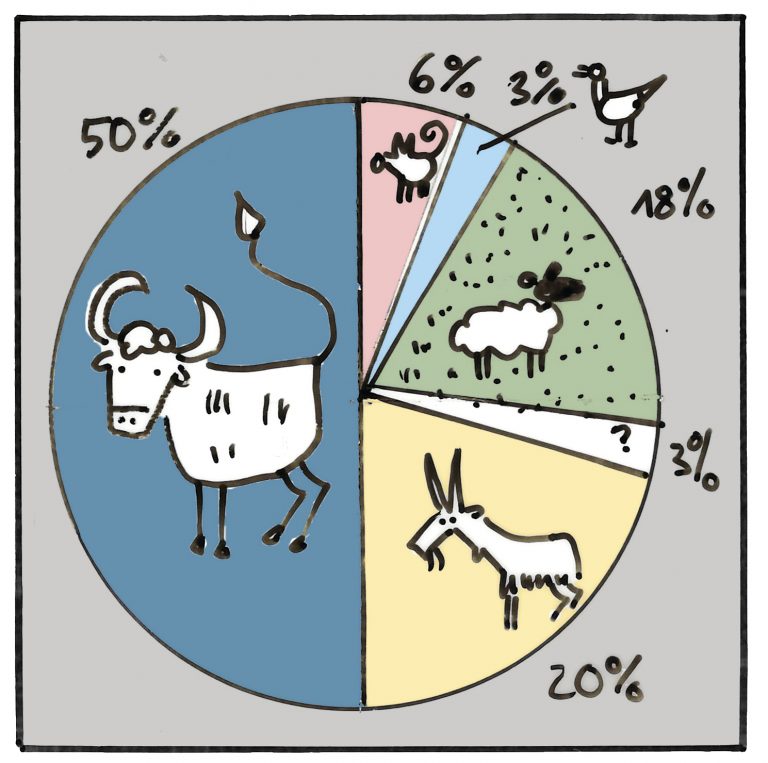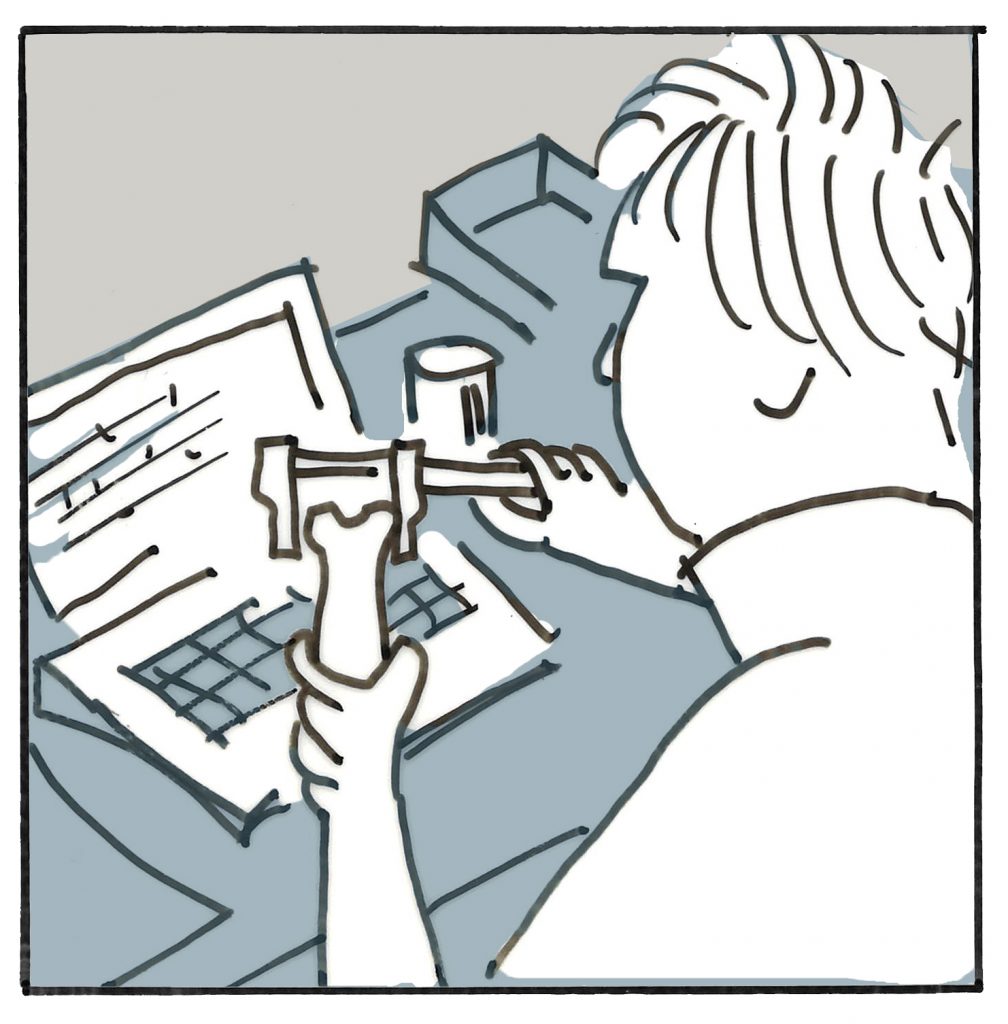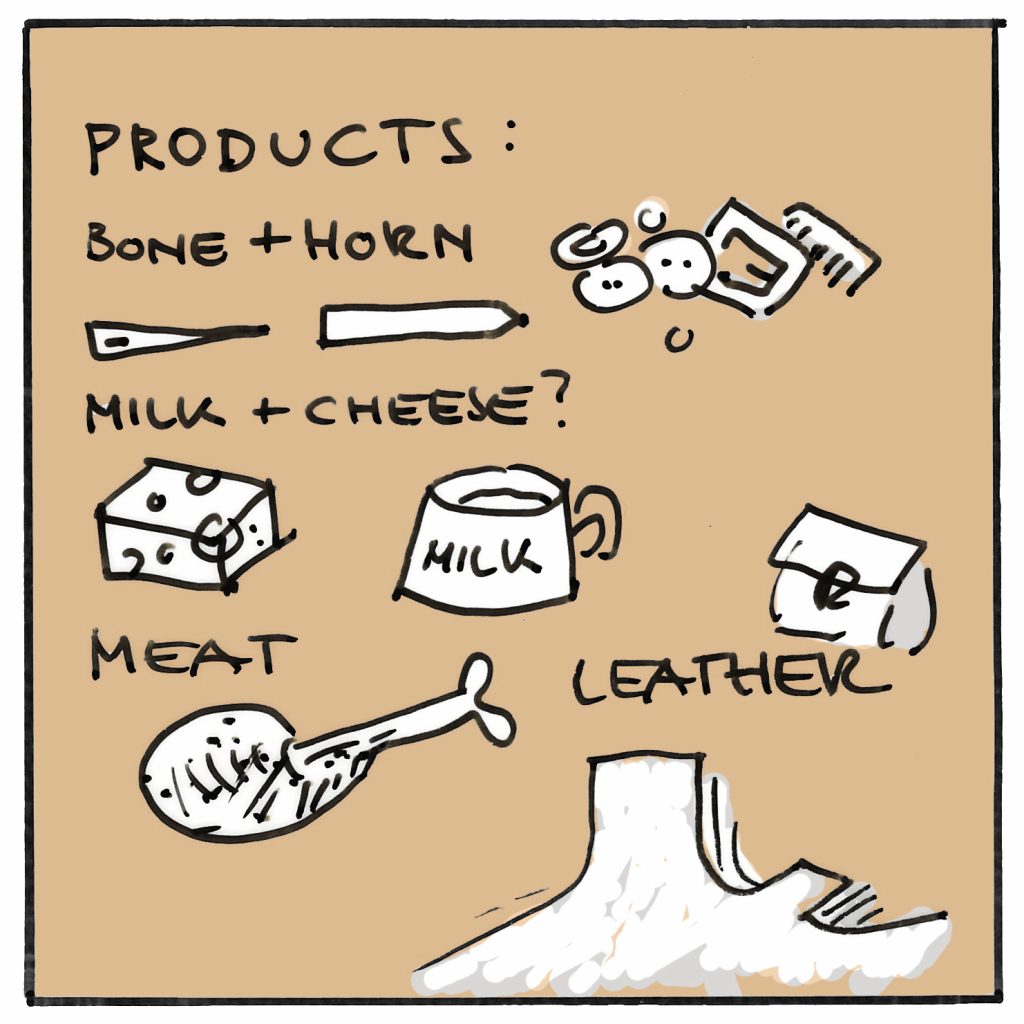Zooarchaeology is the study of archaeological animal remains, which include materials like bones, teeth, and shells. Unlike biology or paleontology, zooarchaeology focuses on human-animal interactions and the impacts of those interactions on human culture, the environment, and the animals themselves. As one of the most abundant categories of artifact recovered during excavation, animal remains allow zooarchaeologists to investigate everything from the reconstruction of human diets and environmental conditions to broader social phenomena like urbanism or ethnic identity. Animals played significant roles in nearly every aspect of human society and, consequently, their remains can be used to investigate a wide range of research topics related to the human past.
Archaeological animal assemblages are the combined result of both cultural and natural factors, from human choice in the care of live animals and the eventual discard of dead ones to environmental transformations that effect the integrity of bones. Assemblages are also affected by excavation decisions, such as where archaeologists excavate and how they choose to collect animal remains. Following excavation and recovery, zooarchaeologists analyze animal remains to understand the impact of each of these factors, recording features such as element, species, age, sex, pathologies, fragment and element size, and cultural and environmental modifications, such as butchery, burning, or animal gnawing. Depending on the research question, zooarchaeologists can also extract other types of data, like isotopes or DNA. Physical and digital comparative collections of modern animal skeletons are used to help identify specimens, while published literature is consulted to determine other variables like age and sex. Zooarchaeologists interpret these datasets to determine how humans used and related to animals in the past, as well as how those interactions impacted the development of archaeological sites and the surrounding environmental landscapes.
By combining these variables, zooarchaeologists can interpret animal remains in the context of broader social phenomena. For example, demographic data can indicate the goals of animal management strategies and changes in those strategies over time. For instance, high frequencies of large, senior, male sheep may indicate intensive wool production and elite-wealth accumulation, while a subsequent shift to a wider range of ages might indicate significant environmental fluctuations or a period of decentralization. Alternatively, pathologies can indicate the types of jobs that animals performed, as well as their health and the levels of care afforded them. For example, the presence of abnormal bone growths on the foot and ankle of cattle can indicate their use as draft animals and further suggest periods of agricultural intensification, while oral lesions might indicate poor quality diet or the consistent use of specialized equipment, such as bits in horses. These are but a few examples of the types of information and interpretations that zooarchaeologists can glean from archaeological animal remains.
Zooarchaeological Investigations at Bronze Age Boğazköy-Hattuša
As a zooarchaeologist, my own research focuses on the human-animal relationships that sustained the Bronze Age city of Boğazköy-Ḫattuša. Ḫattuša was home to a diverse population of workers, craftspeople, soldiers, administrators, priests, royalty, and the so-called “1000 gods of Hatti,” who lived alongside all manner of domestic and wild animals, ranging from livestock and other domesticated animals to wild game and even dangerous predators. Drawing on the extensive zooarchaeological record produced by DAI excavations as well as my own hands-on research, I investigate the ways in which these animals contributed to urban development at Hattuša, as well as the geographic scale of these animal economies and how they changed over the course of the 2nd millennium BC.
At the heart of my research is the assertion that animals were integral to nearly every aspect of urban life at Ḫattuša. On a material level, meat and dairy were important dietary staples. Fibers like wool, felt, and fur were used to make textiles, pay dependents, and accumulate wealth, while skins were made into leather that could be used to make products like clothing, shoes, and storage containers. Fats were made into lard and tallow for cooking, lamps and sealants, cultic scents, and cosmetics, while tendons made durable threads and specialized tools like bow strings. Bones, horns, and teeth could be processed into needles, handles, cups, jewelry, game pieces, and musical instruments. Carcasses could be boiled to make glues and even animal dung was used to fertilize crops, fuel hearths, and construct buildings.
Live animals were also integral to urban life at Ḫattuša. Cattle plowed fields and transported heavy building materials, while donkeys were used in long-distance trade and horses in chariot warfare. Dogs could be trained as livestock guardians, game hunters, or even sentries, cats likely guarded granaries from the ever-looming threat of rodents, and pigs played an important role in managing urban waste. On a more ephemeral level, animals were also used to solidify social and religious ideologies through activities like taxation, feasting, hunting, sacrifice, and divination. For example, texts suggest that the king hunted dangerous animals, such as lions, leopards, and bears, and might have even kept them in royal menageries, as a demonstration of his ability to tame nature and maintain order in chaos. Furthermore, the king’s regular participation in animal sacrifices and divination rituals would have solidified his position at the top of Ḫattuša’s human social ladder and assured the gods of their rightful place above him. As these examples highlight, a wide variety of human-animal interactions were essential to the continued success of ancient cities like Ḫattuša.
Within these products, services, and relationships in mind, I define “urban animal economy” as the multitude of human-animal interactions that take place within and around urban landscapes. Therefore, within my doctoral research, I argue that Ḫattuša’s zooarchaeological record is best understood as a product of these diverse relationships, networks, and goals. Within this framework, the urban landscape becomes a more realistic and complex environment. To test this hypothesis, I compare animal remains from different districts and buildings across this sprawling city using both zooarchaeology and isotope analysis. My own analysis focuses on animal bones recovered from monumental and administrative buildings, domestic structures, and neighborhood streets in the recent excavated Northern Lower Town. These data will be compared with previous studies of animal bones recovered from other areas of the Upper and Lower Towns, as well as the plateau atop Büyükkaya.
If Ḫattuša’s urban communities were indeed supplied by multiple economic networks, I expect to find unique animal demographic profiles across different areas of the site. For example, I might find that wool-producing sheep are concentration in administrative buildings, while backyard-fattened pigs are more common in domestic households. Distinctions such as these can be used to indicate the existence of multiple animal economies serving different communities with different products and services. Additionally, I use isotope analysis to investigate the geographic scale of the networks that supplied livestock to the city, focusing specifically on sheep, goat, cattle, and pig recovered from the Royal Palace. These analyses will help determine whether Ḫattuša’s livestock economies were supplied primarily through local or long-distance provisioning, particularly as the Hittite Empire grew to encompass much of the Eastern Mediterranean. Finally, I will compare these datasets diachronically to determine how animal economies changed as the city developed into Anatolia’s first imperial capital. This project is on-going, with analysis currently taking place at Koç University’s Research Center for Anatolian Civilizations (ANAMED), where I am a PhD Fellow.
Christine Mikeska, PhD Candidate,
University of North Carolina, Chapel Hill
Further Reading
Adcock, S. E. (2020). After the End: Animal Economies, Collapse, and Continuity in Hittite and Post-Hittite Anatolia. The University of Chicago.
Bartosiewicz, L., & Gal, E. (2013). Shuffling nags, lame ducks: The archaeology of animal disease. Oxbow books.
Berthon, R. (2017). Faunal Remains of the Hittite and Byzantine Periods from the Middle Plateau. In A. Schachner (Ed.), Ausgrabungen und Forschungen in der Westlichen Oberstadt von Hattuša II (pp.255-258). De Gruyter.
Berthon, R. (2017). Herding for the Kingdom, Herding for the Empire. The Contribution of Zooarchaeology to the Knowledge of Hittite Economy. In A. Schachner (Ed.), Innovation versus Beharrung: Was macht den Unterschied des Hethitischen Reichs im Anatolien des 2. Jahrtausends v. Chr. (pp. 175-184). Ege Yayinlari.
Bryce, T. (2002). Life and Society in the Hittite World. OUP Oxford.
Bryce, T. (2005). The Kingdom of the Hittites. OUP Oxford.
Dörfler, W., Herking, C., Neef, R., Pasternak, R., & Von Den Driesch, A. (2011). Environment and Economy in Hittite Anatolia. Insights into Hittite History and Archaeology (pp. 99-124). Isd.
Hoffner, H. A. (1974). Alimenta Hethaeorum: Food Production in Hittite Asia Minor. American Oriental Series.
Hoffner, H. A. (1997). The Laws of the Hittites: A Critical Edition (Vol. 23): Brill.
Hollenstein, D., & Middea, G. (2016). The Faunal Remains from the Square Building Horizon in the Valley West of Sarıkale, Boğazköy-Hattuša, Turkey (16th/15th Century BC). In A. Schachner & J. Seeher (Eds.), Ausgrabungen und Forschungen in der Westlichen Oberstadt von Hattuša I. De Gruyter.
Klengel, H. (1986). The Economy of the Hittite Household (É). Oikumene, 5, 23-31.
Klengel, H. (2007). Studien zur Hethitischen Wirtschaft, 3: Tierwirtschaft und Jagd. Altorientalische Forschungen, 34(1-2), 154-173.
O’Connor, Terry (2013). The Archaeology of Animal Bones. The History Press.
Reitz, Elizabeth J.; Wing, Elizabeth S. (2008). Zooarchaeology, Second Edition. Cambridge Manuals in Archaeology. Cambridge University Press.
Russell, N. (2011). Social Zooarchaeology: Humans and Animals in Prehistory. Cambridge University Press.
Schachner, A. (2017). The Historical Development of the Urban Geography of Hattuša, the Hittite Capital City, and Beyond. In M. Alparslan (Ed), Places and Spaces in Hittite Anatolia I: Hatti and the East, Proceedings of an International Workshop on Hittite Historical Geography in Istanbul, 25th-26th October 2013 (pp. 29-51). Ege Yayinlari.
Schachner, A. (2020). The Power of Geography: Criteria for Selecting the Location of Hattuša, the Capital City of the Hittite Empire. talugaeš witteš: Ancient Near Eastern Studies Presented to Stefano de Martino on the Occasion of his 65th Birthday (pp. 399-420). Zaphon Munster.
Schachner, A. (2021). Die Ausgrabungen in Boğazköy-Ḫattuša 2020. AA 2021-1: 9-64.
Schachner, A. (2022). Geographical Prerequisites versus Human Behavior: Settlement Geography, Rural Economy, and Ideological Aspects of Anthropogenic Relations with the Natural Environment during the Second Millennium BC in Central Anatolia. In S. de Martino, Handbook of Hittite Empire. Power Structures (pp. 159-202). De Gruyter.
Von den Driesch, A., & Boessneck, J. (1981). Reste von Haus-und Jagdtieren aus der Unterstadt von Bogazkoy-Hattusa: Grabungskampagnen 1958-1977: G. Mann.
Von den Driesch, A., & Pöllath, N. (2002). Changes from Late Bronze Age to Early Iron Age Animal Husbandry as Reflected in the Faunal Remains from Büyükkaya/Bogazköy-Hattuša. Paper Presented at the Identifying Changes: The Transition from Bronze to Iron Ages in Anatolia and its Neighbouring Regions. Proceedings of the International Workshop, Istanbul (pp. 295-9). Türk Eskiçağ Bilimleri Enstitüsü.
Von den Driesch, A. & Pöllath, N. (2004). Vor-und frühgeschichtliche Nutztierhaltung und Jagd auf Büyükkaya in Boğazköy-Ḫattuša, Zentralanatolien. Verlag Philipp von Zabern.
Zeder, M. A. (1991). Feeding Cities: Specialized Animal Economy in the Ancient Near East. Smithsonian Institution Press.
